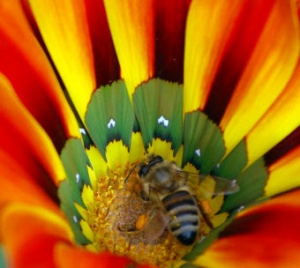Classifying and organising living things using images: Difference between revisions
JanetBlair (talk | contribs) m (removed Teacher Education category) |
mNo edit summary |
||
| Line 4: | Line 4: | ||
|resourcenumber=SC008 | |resourcenumber=SC008 | ||
|age=NA | |age=NA | ||
|image=Bee-gathering-polen602.jpg | |||
|tagline=Find several different ways to classify living things | |||
|title= Classifying and organising living things using images | |title= Classifying and organising living things using images | ||
|content= | |content= A lesson activity outline where students sort images of living things into groups. They may do this using photo album software on the computer and furthermore, use a variety of headings to sort the living things under. A variation of this idea can make a lesson starter activity to raise discussion points about classification in science. | ||
|format= | |format= An activity outline and sample photos. | ||
|strategy= | |strategy= | ||
| Learning Objectives = | | Learning Objectives = | ||
* To have experience | * To have experience and develop confidence with the different ways in which living things can be classified into groups | ||
* To develop knowledge of and use some of the characteristics of living things and ways to classify and organise them. | * To develop knowledge of and use some of the characteristics of living things and ways to classify and organise them. | ||
|additional resources= | |additional resources=Access to computers or tablet will allow pupils to organise the images (supplied as photos in one .zip file) | ||
|useful information= Using photo organization/slideshow software (Picasa) students organise images that have been provided into various groups or categories. They may also add labels and/or descriptions where appropriate. | |useful information= Using photo organization/slideshow software (Picasa) students organise images that have been provided into various groups or categories. They may also add labels and/or descriptions where appropriate. | ||
|related resources=[[Organising images for a narrative]], [http://www.youtube.com/watch?v=p96CArgf0gY OER4schools] | |related resources=[[Organising images for a narrative]], [http://www.youtube.com/watch?v=p96CArgf0gY OER4schools] | ||
|other= | |other= | ||
|resources= | |resources= | ||
* | * The activity outline includes links to photographs of living things: [[Classifying and organising living things using images/activity]] | ||
* The activity outline also mentions a further task which is to label or annotate astronomy images (included0 | |||
}} | }} | ||
[[Category:Science]][[Category:Primary]][[Category:Image based activities]] | [[Category:Science]][[Category:Primary]][[Category:Image based activities]] [[Category:ICT]] | ||
Revision as of 18:29, 16 September 2012
Lesson idea. A lesson activity outline where students sort images of living things into groups. They may do this using photo album software on the computer and furthermore, use a variety of headings to sort the living things under. A variation of this idea can make a lesson starter activity to raise discussion points about classification in science.
Teaching approach. This lesson offers opportunities to explore ways to classify living things as well as characteristics which might be relevant, and how to address difficulties that may arise when trying to classify things in this way. The activity may be enhanced by the use of ICT(i) software (e.g. Picasa) but could be carried out with paper-based resources.
This lesson presents a good opportunity for small group work(ta) and some inquiry(ta) into how we classify; and why some classification methods might be more useful, or more scientifically interesting than others. There is also a good opportunity to use different sorts of questioning(ta); to encourage pupils to question each other; to engage in peer assessment(ta) and to focus discussion(ta) on the scientific method(ta) using key vocabulary(ta). (edit)
| Resource details | |
| Title | Classifying and organising living things using images |
| Topic | [[Topics/Living things|Living things]], [[Topics/Using images|Using images]] |
| Teaching approach | [[Teaching Approaches/Assessment|Assessment]], [[Teaching Approaches/Questioning|Questioning]], [[Teaching Approaches/Language|Language]], [[Teaching Approaches/Group work|Group work]], [[Teaching Approaches/Inquiry|Inquiry]], [[Teaching Approaches/Discussion|Discussion]], [[Teaching Approaches/Scientific method|Scientific method]] |
| Learning Objectives |
|
| Format / structure | An activity outline and sample photos. |
| Subject | [[Resources/Science|Science]] |
| Age of students / grade | [[Resources/Primary|Primary]] |
| Additional Resources/material needed | Access to computers or tablet will allow pupils to organise the images (supplied as photos in one .zip file) |
| Useful information | Using photo organization/slideshow software (Picasa) students organise images that have been provided into various groups or categories. They may also add labels and/or descriptions where appropriate. |
| Related ORBIT Wiki Resources | |
| Files and resources to view and download |
|

